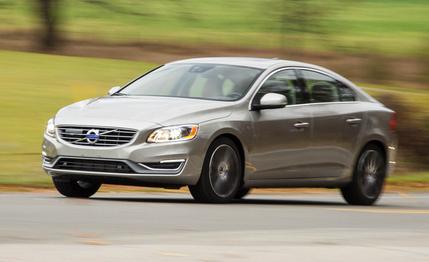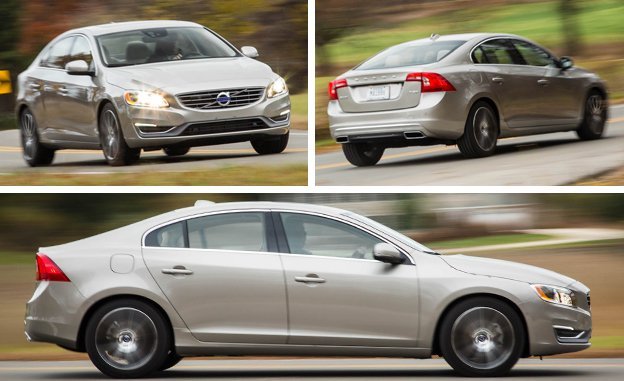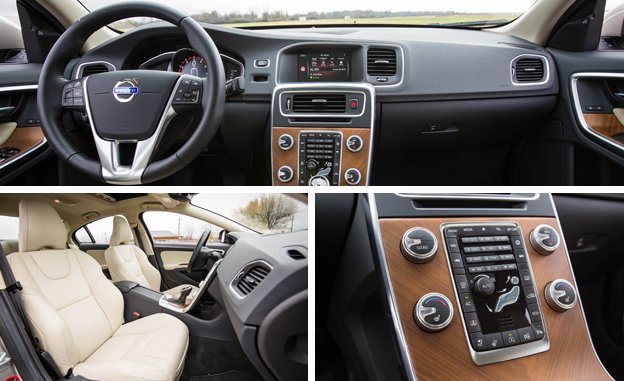
 Instrumented Test
Instrumented Test
Volvo fans are rightly focused on the excitement happening at the upper reaches of the company’s model range, where the XC90 crossover and the upcoming S90 flagship sedan have been capturing headlines. There’s an addition to the firm’s more mainstream S60 range for 2016 that shouldn’t escape notice, though. Salient facts about this S60 Inscription model are that it has a 3.1-inch-longer wheelbase to add 3.0 additional inches of legroom into the back seat and, like many other Volvos of late, its drivetrain is a fresh 2.0-liter direct-injected turbo four mated to an eight-speed automatic transmission.
Oh, and it’s built in China, homeland of Volvo’s corporate parent, Geely. This stretched Volvo was devised for and is built only in that country, where many owners prefer to sit in the rear and let someone else deal with Sino-traffic nightmares. There, it’s called the S60L and, presumably, pride attaches to local assembly in Chengdu. Here, it’s a sort of pioneer—among all production cars available in the U.S. as of this writing, the Inscription alone wears Made in China labels (other S60s hail from Sweden).
Instead of S60L, the model is known here as the Inscription, which at least it has the distinction of being a word rather than another alphanumeric complication in a range that already has plenty of those. Available with either front-wheel drive (as in our test car) or all-wheel drive (which brings a 2.5-liter turbo five-cylinder and a six-speed automatic), the Inscription comes in two trim levels, Premier or Platinum. This example was a Platinum, which bumps the buy-in upward by three grand and brings premium sound (Harman/Kardon), high-tech headlights (bixenons that point where you steer and have their own washers), and equipment Premier buyers get only by choosing both the Convenience (passive entry, grocery-bag holders, power-retracting mirrors) and Technology option packages (a long list of safety add-ons we’ll address later).
What a front-wheel-drive Inscription can’t have is any other powertrain. The turbocharged 2.0-liter makes 240 horsepower in this T5 guise. Volvo makes a T6 version using both a supercharger and a turbo to generate 302 horsepower, but offers it only in the standard-wheelbase model, which we tested previously. Our most recent S60 test was of the special-edition Polestar variant propelled by a 345-hp inline-six engine that has no place in Volvo’s future, mated to a six-speed automatic (also not part of the brand’s long-term plans) and all-wheel drive.


With more Volvo to move and fewer ponies to pull it, the Inscription proved to be the slowest S60 we’ve tested. The 3698-pound Inscription got to 60 mph in 6.3 seconds, or 0.9-second slower than the standard-wheelbase T6 that weighed 14 pounds more. Still, that zero-to-60-mph time, along with a 14.7-second, 97-mph quarter-mile sprint, constitutes a good, solid performance. An above-average 0.90-g rating on the skidpad was somewhat offset by determined understeer, although the S60 Inscription showed measurably more roadholding and braking grip than we recorded in our earlier test of the standard-wheelbase T6 model, which rode on essentially the same tires.
So much for track numbers. Over the road, the longer wheelbase not only adds 3 cubic feet of cabin volume behind the B-pillar, it improves the ride quality over rough pavement. It also dulls the sense of responsiveness that we’ve enjoyed in S60s with sport-suspension upgrades. A sportier suspension is another thing luxury-oriented Inscription customers can’t get but presumably don’t want.
The engine delivers torque aplenty and the transmission does a good job of making use of it while returning a real-world 25 mpg in our hands, smack on the EPA city rating and 1 mpg better than we got in the T6. You’d need a gentle toe on the gas pedal to approach the EPA’s 37-mpg highway estimate, but those motivated to choose this version of the S60 aren’t likely to be hard drivers and should get better economy than we did.
The wheelbase stretch makes the back seat a good-enough place for adults, although the total cabin volume still falls short of mainstream mid-size cars such as the Ford Fusion and the 2016 Chevy Malibu. Pretty wood and leather trimmings can no longer fully offset the aging, although elegantly simple, dashboard design with its pictographic buttons for the climate control set amid a giant keypad that makes us think of the Jitterbug phones wielded by nursing-home residents. That said, these controls are easier to find and use while in motion than the systems used by many competitors, and Volvo has updated the functions offered via the 7.0-inch color LCD screen over the years.


Chinese-built though it may be, the S60 Inscription Platinum exemplifies the safety-first, socially responsible Swedish credo of Volvo, inventor of the three-point seatbelt (as it never fails to remind us). Total security may be an illusion but it’s one this car conveys as theatrically as the TSA’s remove-your-shoes, throw-out-your-water-bottle check lines at airports. Start with BLIS, which uses radar to provide front and rear park assist, cross-traffic alerts, and a Lane Change Merge Aid. The Technology package that comes standard on the Platinum trim level adds Pedestrian & Cyclist Detection (a low-speed collision-avoidance system that detects people and will stop the car to prevent hitting them); Active High Beams; Road Sign Information (cameras read speed-limit signs, and the car can inform the driver if he’s speeding); Adaptive Cruise Control with Queue Assist (set the cruise speed as low as 19 mph and it’ll “follow” the car ahead down to a full stop); Collision Warning with Full Auto Brake; Driver Alert Control; and Lane Keeping Aid.
Some of these warnings and alerts and messages can be turned off or adjusted to lower sensitivity. Their frequent intrusion makes one wonder where the line is between keeping people safe and the simple sales-enhancing tool of reminding the consumer that the expensive systems he or she paid for are there and working. Negotiating a commute in the Inscription with the default settings leaves an impression that all that stands between you and your loved ones being torn asunder and set aflame is the arsenal of benevolent electronic overlords. The parent of a new teenage driver might welcome the car’s assistance in making the point that driving is a serious matter, but the drumbeat of warnings and alerts does tend to undermine any sense that mastery of the skills involved could be an enjoyable pursuit.
Comfortable and quiet with plenty of entertainment options to be found via the console screen, the Inscription’s appeal resides as much in the back seat as it does behind the wheel. Speaking of entertainment reminds us of a glitch we experienced: One driver started this car and found nothing that uses the speakers would work—there’s a way to mute the various systems, which he thought was the problem, but not even cycling the engine off and back on worked to restore audio. Finally, the navigation, voice control, and audio entertainment systems came back to life only following a stop for gas, which must have triggered what the software geeks among us would call a cold reboot. Cue Chinese-assembly joke? Not so fast. We saw an even more severe case of electronic brain fade in our long-term test of a 2012 S60. One can only hope the array of electronic safety nannies is less inclined to take unscheduled naps. As for the Inscription’s enlarged rear seat, it’s more appropriate for naps of the human kind.